
for many, things change in their teens.
Image © J. Maus/BikePortland
Statistically speaking, girls and boys tend to have similar attitudes toward bikes until their 14th birthday or so. But around that age, gender attitudes diverge dramatically – and no one’s quite sure why.
As they enter puberty, Portland girls suddenly start reporting much more concern about not knowing “how to exercise the right way,” according to a new study. That’s also the age at which girls start worrying more than boys do about hurting themselves if they’re physically active.
Portland State University researcher Tara Goddard, who presented those findings to colleagues Friday, wonders if girls and boys should get different sorts of encouragement as they build active teen lifestyles.
“Maybe we need to catch them before this split starts to happen,” Goddard said Friday. “Otherwise you’re kind of working backwards and trying to repair that split.”
Boys who turn 14 may still worry about the same issues, Goddard’s research shows, but it tends to be at the same rates they did when they were younger.
Another big divide between girls and boys relates to their attitudes toward their peers. Whether or not boys ride bikes themselves, they feel about the same way about whether other kids their age ride bikes for transportation and whether biking to school is “cool.”
But girls who like bikes are much more likely than girls who don’t like bikes to say their peers think highly of bicycles.
“By age 14, girls are embarrassed to be seen exercising,” Goddard said – and girls who feel that embarrassment more are much less likely to ride bicycles. “Do girls think of bicycling as a non-trivial physical activity?” Goddard wondered. “Or you could look at it the other direction: do girls who like bicycling have this body confidence and they’re more comfortable being seen exercising?”
Goddard has looked into different programs designed to attract teens to biking. She found that public health programs tend to be more about discouraging unhealthy behavior – stopping smoking, for example – than encouraging healthy behavior.
She also said it’s hard to find programs targeted directly toward helping girls build social connections with peers who ride bikes.
“A lot of girls are more likely to report the influence of their peers, so can we take advantage of that to be able to leverage the influence of bicycling as a transportation mode?” Goddard asked.
Bike-fun groups like Portland’s Sprockettes, who recently started operating a summer bike-dance camp for girls, do come to mind. I also thought about this amazing video from a group of young Minneapolis rappers, both boys and girls, about their love of bikes.
This gender split among tweens is one tantalizing drip from a geyser of new data about to emerge from a three-year, $400,000 study of 323 Portland households’ travel behavior. The study was funded by the Robert Wood Johnson Foundation, OTREC and the City of Portland, and it promises a huge amount of new data on how families who live in different neighborhoods navigate our moderately multimodal American city.
“This is just the very first cut – the exploratory stuff,” Goddard said. “During the next six months to a year to 18 months, there’s going to be a lot of cool stuff coming out on this project.”


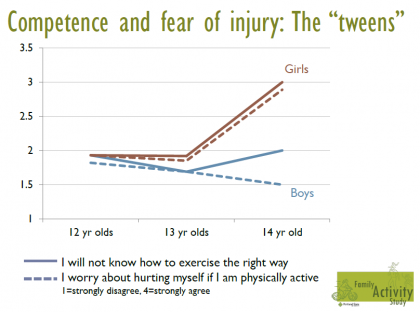
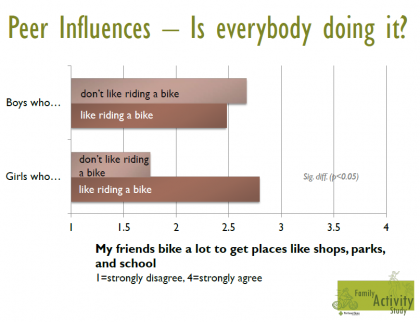
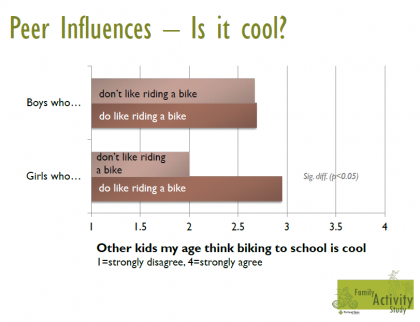

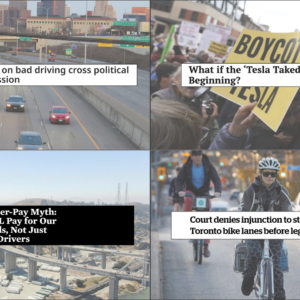
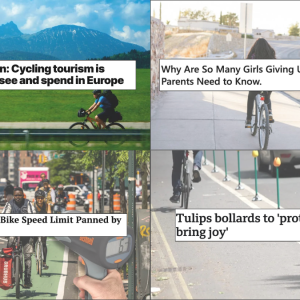

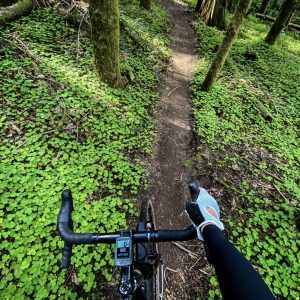
Thanks for reading.
BikePortland has served this community with independent community journalism since 2005. We rely on subscriptions from readers like you to survive. Your financial support is vital in keeping this valuable resource alive and well.
Please subscribe today to strengthen and expand our work.
Fourteen is about the age girls understand that for them there are more important things.
I find that a really sad remark: Bicycling can help with many things that concern 14-year old girls – from menstrual cramps to processing stress… what can be more important?
As I am sure many of you know, the invention of the bicycle was a tool for woman to empower themselves in ways that many did not see coming at the time.
While being involved with couple of bicycle touring/riding clubs in the 70-80’s, just keeping kids interested in cycling at this “breaking age point” no matter which gender, can be difficult.
We are lucky to live in a place such as P-town where the continuity of passing through this period of bike as fun, into bike as lifestyle, can be seen as seamless and natural.
This article seems to say (to me at least) that the typical gender issues we have known and struggled with for eons, can still influence a young persons outlook very easily.
I believe that younger people are embracing the bicycle again, at least it seems they are for many reasons.
I hope millions of girls see the beauty in it.
I hate riding with guys all the time, that gets boring.
As a local soccer coach for this age group, I’ll just add that there is a lot of attrition from the soccer teams at this age as well. Our club went from 3 full teams of 11-year-olds to barely fielding one team of 13-year-olds.
Still, team sports provide built-in support and encouragement for athleticism. Maybe some road/cross/MTB teams for this age group?
Girls 13-14 are all about reinventing their image. Girls who took ballet drop it and take up track. Girls who played softball took up cheerleading. I took up competitive swimming at 13.
Researchers say that school-affiliated activities are more popular than ever before at this age. Who you are in high school is defined by what teams and clubs you’re a member of.
You nailed it!
At 14 you want to be anywhere but home. You are too young to drive so you ride a bike. Boys seem to be in skateboard mode these days more so than girls
FYI –
For anyone interested in the study size…
The seminar description says that 490 aged 4-17 years were in the study.
_If_ the children’s ages were evenly distributed that would put about (3 years)/(14 years) * 490 = 105 children in the 12-14 year bracket and 35 children in each year bracket.
_If_ the genders were evenly split, this would 35/2 =17.5 -> about 18 children in each age/gender bracket.
So what I’m trying to say is that the results are interesting and worth studying more, but the sample sizes aren’t huge and a larger study might show different results.
The study covered 2 years. So we had 1 week in 2012 and one week in 2013 that we wore the pedometer & GPS. So the chances of the kids crossing the age of interest is higher. From my perspective as a participant the study was done with a high degree of thought. Hopefully soon we will be able to see the statistics in detail.
My 14 year old daughter and I were involved in this study and just like the graphs show, she stopped riding around 13. She pesters me about driving her places and prefers riding the bus. It’s frustrating since I like to bike everywhere and she was raised on trailers, tag-alongs & bikes.
My 13 year old daughter will not have transportation to school this coming year. So, she’ll need to walk 2 miles up a hill to get home. I offered to buy her an ebike to make the hill climbing easier. She looked at the ebike and said she’d be embarrassed to be seen on it. So I asked her if she’d prefer a one-hour uphill walk to 10 minutes on an ebike. She prefers the walk. Walking looks cool. Biking, particularly with a helmet, is considered unattractive.
Interesting. My daughter started to develop a somewhat negative view of riding around age 13+, that continued until about age 17 when she started looking around the world a bit and realized that the people she thought were cool & looked up to in their late teens/early 20’s were all riding bikes everywhere. She’s now in her mid-20’s and the bike is her vehicle of choice.
Watching bike use at high schools go from virtually zero in the early 2000’s to an accepted form of transportation now (just look at the overflowing bike racks at Cleveland, Grant, etc.) – still plenty of room for growth, but it’s clearly not a marginalized activity among (most) high schoolers anymore. That’s a good sign, & to my mind one we can thank the generally helmetless, lightless, fixie-riding young hipsters for. Yeah, not my perfectly ideal choice for a role model for my daughter, but a whole lot better than many of the other possibilities.
Yes, the bike racks at Cleveland are packed every day. It will be interesting to see trends over time in this research.
Just as an anecdotal side note, when my daughter went to Cleveland HS in 2003 I’d see maybe a half dozen bikes parked to various railings, and that was in good weather. As you note, Chris, this has changed drastically in less than a decade – it’s very encouraging.
I guess I’m very fortunate. My daughter was riding her bike occasionally and riding the bus to school every day in middle school. When she started high school at age 13, she voluntarily (just sort of out of the blue) started riding her bike to school every day, rain, or shine.
I have been a walk & Bike coordinator for 5 years and got my son’s class through elementary school with some girls riding… going to be interesting to see that they do in middle school and if the crazy bike lady achieved something!
Having worked extensively with middle and high school girls through Girl Scouts, girls 13-14 are developmentally unique. Almost overnight they become very concerned about their image and can become narcissistically obsessed about clothes, hair, re-decorating their bedroom, etc.
Unlike riding in a car, when you ride a bike you are very conspicuous in public which can intensify any image concerns girls have. So if riding a bike is considered dorky, forget it. Especially where helmets are involved.
So to me it’s less about being girls not wanting be seen exercising and more about whether bikes are cool or dorky. Bicycling to school or around town is no more “exercising” than walking. It could be that it’s less cool.
Hmmm … so you’re saying that girls stop riding bikes right around the age they start dating boys who have cars? Or was that not one of the survey questions?
Most 14 year old girls don’t date boys with cars. They just want to.
You made a good point above about being “cool.” High school freshman, in general, want to fit in … riding a bike to high school isn’t necessarily a way to fit in, let alone be thought of as “cool.”
(I rode a bike to high school for 3 years … until I got a car.)
With the girls it actually starts in 8th grade, around age 13. I remember waiting for my mom to pick me up at school one day and praying that she would drive our newer car, not the old beater. I didn’t care before.
…”They just want to date boys in cars”…
….. and while wanting too, walk around aimlessly in the neighborhood (in pairs), looking for trouble !
14 was fun, but I would never want to relive it !
I am so glad I have a boy! 🙂 🙂 🙂
Although, I would have loved a daughter,if I had one.
At the school I went to, It would have only taken a couple of the “popular girls” or “popular guys” to dramatically shift the opinion of cycling.
I think a lot of tweens outside of the Portland area see cycling as “a kid with a bmx bike” or “a 40 something with a road bike in lycra” and not the possibility of the cool tennis squad leader riding to school in a stylish dress and boots.
Why are so many girls in the photo on bikes with the seat set too low?
If those girls are anything like the little girls I know, they want to be able to put a foot down when they stop their bike without leaving the seat. A lot of little kid bikes are really heavy, especially compared to the weight of the child, and leaving the seat, standing up, and tilting the frame to the side to put your foot down when stopped is tricky.
It would be interesting to see how this compares across countries with different levels of cycling. Jonathan- another thing to look out for!
I loved riding my bike, still do, but as I recall 14 was about the age that boys (and some men) started screaming “show us your t*ts!!!” at me as I rode by. All of a sudden I felt very on display and exposed.
It still happens, but now I’m a cranky middle-aged woman who just yells back at them.
I read through this entire entry waiting for someone to say this. This is exactly why I stopped walking and cycling everywhere at about 12 years old. Take all of the random abuse you get as a cyclist and multiply it x2 and add creepy sexualization on top. As an adult I can deal with that sort of nonsense, but as a 12 year old who still didn’t have a thought in her head about boys it was very frightening.
“… All of a sudden I felt very on display and exposed. …” Kat
I’d say that’s a good point. As compared to riding in a motor vehicle, on a bike, the rider is on display and exposed. Even for myself, I consider related issues, so for example, I generally wear a comparatively baggy pair of running shorts, rather than skin tight cycling shorts, which are good for being more discreet when off the saddle, up on the pedals
For women, it doesn’t matter what you wear. I get just as many cat calls and jeers when I am in baggy jeans and sweat pants as I do when I’m in my sport cycling lycra. The same was true when I was a little girl.
There is a lot of cultural things at play here for sure. From my own history, i biked and walked to school until till middle school ( where we moved someplace I had to bus to get to the school) and then we moved again and I lived in Davis walking distance from my new MS. Everyone biked to HS. The parking lot was small. No one thought 2 ways if you drove or biked. You wanted to drive because heck you just got your licence! But you biked if not. My girl friends and I all biked to hang out/ meet up when we couldn’t get a car.I cared as much as any tween/teen about being cool/appearances/ etc. I don’t know if that has changed since the early 90’s in Davis, it probably has. But if the culture is to bike, I wonder if it’s less of a drop off.
Some Monterey County teen girls told me there are four main reasons they personally don’t bike much: (1) helmets are required for under 18 by California law, and many girls don’t like the appearance of helmets and/or don’t own one; (2) concern about theft of bikes and bike parts, even at some schools; (3) they are excited about being able to drive now, so give up two wheels for four; (4)their parents don’t think it’s safe for them to bike. (All of these topics are further addressed on the Bicycling Monterey website.) Some of these girls still ride and most often do so with their dads, who love to bike.
The above four reasons are also relevant for many teen boys who stop biking, or bike less often.
Social bike runs in Salinas and elsewhere around Monterey County do draw some teen girls, although boys turn out in higher numbers.
Do you hear discussion in California, of modifying the age limit down to 16 or 15? That could be a decent, reasonable way of supporting the development of maturity and good judgment without an extraordinary risk.
If the appearance of bike helmets is all, or the main thing the girls told you they didn’t like about bike helmet usability, I suppose that’s not what I would have expected. The inability of bike helmets to be compatible with a hairdo having any kind of loft, or hold, seems to me to be a big downside of helmet usability.
I think there’s probably practical, appealing ways to overcome some of that problem though. Helmets can be designed to look closer to how people want them to look…people can be helped out with ideas about how to shape up their ‘do after having worn the helmet during a ride.
I think it has to do with menstruation. the shame of possibly leaking makes any form of exercise (which exacerbates the blood flow) taboo. At 14 the shame is overwhelming.
Those girls need to be given a copy of Our Bodies, Ourselves. There is nothing shameful about menstruation. Children have to be taught shame and we should not be teaching them to be ashamed of theiown bodies.
That should be “their own.”
Also, we need better health and sex education in this country.
If we can invent a way to safe way to blend their favorite thing to do (TEXTING) while bicycling, we may find a greater appreciation from today’s youth. Will someone please get to work work on that.